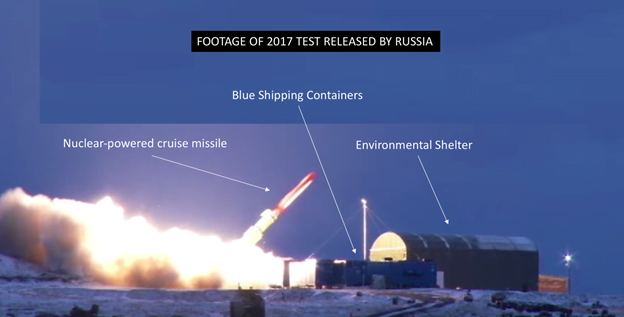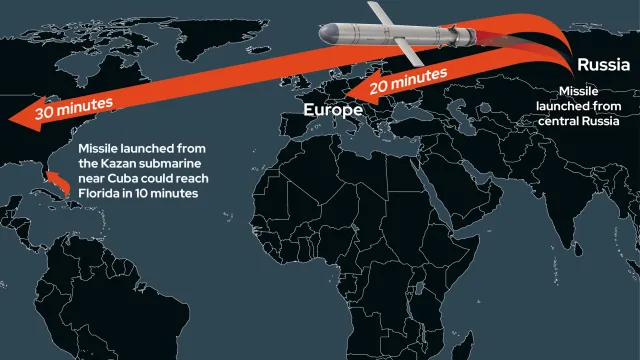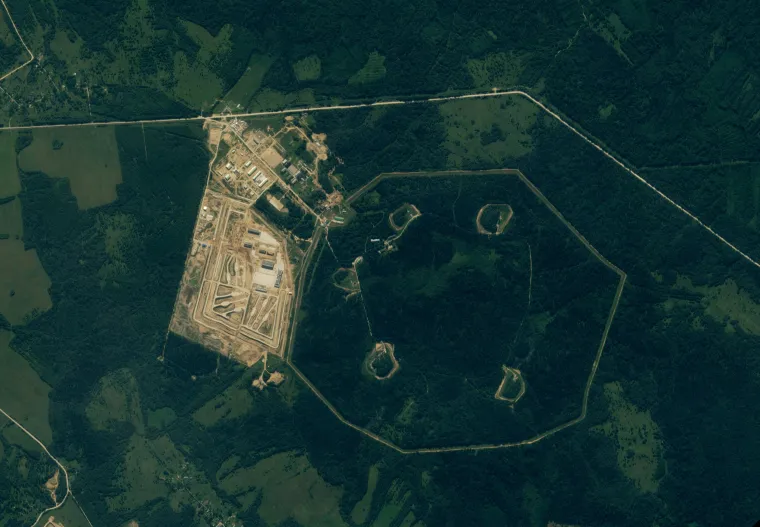Recently, Russia’s latest nuclear missile, the 9M730 Burevestnik—nicknamed “the Flying Chernobyl”—has gained global attention. This is because U.S. researchers believe they have identified the missile’s deployment site, which NATO refers to as SSC-X9 Skyfall, near an existing nuclear warhead storage bunker in Vologda, about 295 miles north of Moscow.
The U.S. researchers have also released satellite images they captured. However, no one has precise knowledge about the missile’s capabilities and features, owing to Russia’s long-standing secrecy. Since Vladimir Putin announced the project to develop “invincible” weapons in 2018, analysts have been puzzled as to why Russia is producing a missile they believe will add little to its already substantial nuclear arsenal.
Table of Contents
9M730 Burevestnik
This is Russia’s new nuclear-armed missile, which reportedly has the capability to circle the Earth for an indefinite period. The missile’s potential for catastrophic consequences has earned it the nickname “the Flying Chernobyl.” It is believed the missile has completed its testing phase and is now stationed in designated locations, ready to be launched if necessary.

On October 5, 2023, Russian President Vladimir Putin claimed the missile had been successfully flight-tested. However, many prominent media outlets, such as the BBC, express doubt, as no concrete evidence has been provided. Several analysts have reported that Burevestnik was only partially tested and has failed at times. Recent reports suggest that Russia is preparing to station it near nuclear storage facilities like Vologda-20. These reports also indicate that the missile may be launched soon, leading to significant challenges and potential global atrocities.
Read this also: Historic Peace Pact in Tripura Marks End to Decades-Long Insurgency
Key Aspects of the Flying Chernobyl
Nuclear-Powered Propulsion
The defining feature of the 9M730 Burevestnik is its nuclear-powered engine, theoretically giving it an almost unlimited range. The nuclear propulsion system allows it to fly for extended periods, as it does not rely on conventional fuel limitations.
Stealth and Maneuverability
Russia claims the missile has advanced stealth capabilities and can maneuver mid-flight to avoid detection and interception by enemy defenses, significantly enhancing Russia’s nuclear arsenal.

Nuclear Warhead Capability
The missile is intended to carry a nuclear warhead, making it a strategic long-range deterrent weapon.
Strategic Importance
President Vladimir Putin first revealed the Burevestnik missile in 2018 as part of a series of advanced Russian weapons systems, including hypersonic weapons, aimed at countering Western missile defense systems. He labeled it an “invincible” weapon. Russia’s goal is to create a missile that can evade U.S. and NATO missile defense networks.
Read this also: Kaivalya Vohra: The 21-Year-Old Billionaire Who Built a ₹3,600 Crore Empire with Zepto
Strategic Ramifications
If successfully deployed, the Burevestnik would represent a significant leap in Russia’s missile capabilities, potentially altering the global strategic balance. However, its development timeline and operational status remain unclear due to the complexity of nuclear-powered missile technology.
Is It a Weapon?
It is believed that the 9M730 Burevestnik was developed as a powerful nuclear weapon. Although its exact features remain unclear, limited information has led experts to conclude that it could severely disrupt global peace and potentially trigger another nuclear conflict, most likely targeting the U.S.

The nickname “the Flying Chernobyl” highlights its destructive potential. The reference to Chernobyl, the catastrophic nuclear disaster of April 26, 1986, underscores the dangers of nuclear energy, human error, and governmental mismanagement. Critics and analysts fear that if Russia launches this missile, it could not only threaten global peace but also cause a major nuclear disaster reminiscent of Chernobyl.












[…] Read this also: Russia’s 9M730 Burevestnik: The “Flying Chernobyl” and Its Potential Global Threat […]
[…] Read this also: Russia’s 9M730 Burevestnik: The “Flying Chernobyl” and Its Potential Global Threat […]